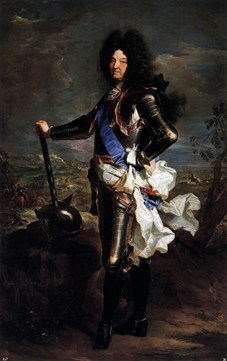The Bourbons
 The cadet branch of the Capetian dynasty, the Bourbons ascended to the throne of France in 1589, at the end of the bloodiest period of the wars of religion with Henry IV (1553-1610), a Huguenot nobleman who converted to Catholicism in order to inherit the French throne. Henry, who was killed in 1610, was succeeded by his son Louis XIII (1601-1643) and later his grandson Louis XIV (1638-1715, image). The fate of the Bourbons was merged with that of France until 1830, when he was deposed as the last ruler of the dynasty, Charles X (replaced by Louis Philippe d’Orléans, a member of a cadet branch of the Bourbons). Following the War of the Spanish Succession (1701-1713), the Bourbons also occupied the Spanish throne with Philip of Anjou (1683-1746), grandson of Louis XIV crowned as Philip V. The Bourbons of Spain, who are still reigning, were at the origin of the branches of the Bourbons of Naples, the sovereigns of the kingdom of Naples, and, starting from 1815, the kingdom of the Two Sicilies until the dissolution of the latter (1860), and the Bourbons of Parma, the sovereigns of Parma and the current Grand Dukes of Luxembourg.
The cadet branch of the Capetian dynasty, the Bourbons ascended to the throne of France in 1589, at the end of the bloodiest period of the wars of religion with Henry IV (1553-1610), a Huguenot nobleman who converted to Catholicism in order to inherit the French throne. Henry, who was killed in 1610, was succeeded by his son Louis XIII (1601-1643) and later his grandson Louis XIV (1638-1715, image). The fate of the Bourbons was merged with that of France until 1830, when he was deposed as the last ruler of the dynasty, Charles X (replaced by Louis Philippe d’Orléans, a member of a cadet branch of the Bourbons). Following the War of the Spanish Succession (1701-1713), the Bourbons also occupied the Spanish throne with Philip of Anjou (1683-1746), grandson of Louis XIV crowned as Philip V. The Bourbons of Spain, who are still reigning, were at the origin of the branches of the Bourbons of Naples, the sovereigns of the kingdom of Naples, and, starting from 1815, the kingdom of the Two Sicilies until the dissolution of the latter (1860), and the Bourbons of Parma, the sovereigns of Parma and the current Grand Dukes of Luxembourg.
